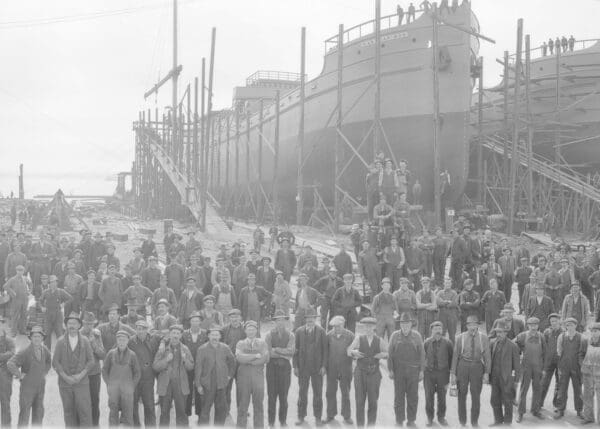01. Shipyard History
History
New York Shipbuilding Corporation was located in Camden, New Jersey. It operated from 1900 to 1967.
The shipyard was active during World War I (WWI), WWII and the Cold War. During WWI, there were so many people working at the shipyard that a self-contained community was established in Camden to house many of the workers. WWII was even more active, with 30,000 employees working for the shipyard and more than 200 ships constructed.
After WWII, New York Shipbuilding Corporation began producing nuclear submarines. The shipyard also began converting cruisers to carry guided missiles.
In total, the shipyard produced more than 670 ships. However, due to decreasing contracts, New York Shipbuilding Corporation closed in 1967. Upon its closing, the shipyard was reorganized into the South Jersey Port Corporation. It was reopened as the Broadway Terminal in 1971, which remains today.
New York Shipbuilding Corporation History at a Glance
- Other Names: New York Ship, The Yard
- Location: Camden, New Jersey
- Owner(s): Merritt Chapman Scott Corporation and Henry G. Morse
- Years of Operation: 1900 – 1967
- Wartime Operations: World War I (WWI), World War II (WWII) and the Cold War
- Number of Employees: More than 30,000 during WWII
- Size of Shipyard: 160 acres
- $ Value of Ships Built Per Year: From March 1942 to March 1943, New York Shipbuilding Corporation delivered $217,000,000 in new naval construction
- Noteworthy Ships: USS Washington, USS Kansas, USS Utah, USS Oklahoma, USS Idaho, USS Saratoga, USS Indianapolis, USS Tuscaloosa, USS Savannah, USS Nashville, USS Albemarle, USS Dixie, USS Prairie, USS Independence, USS Kitty Hawk, USS Little Rock, USS Truxton
- Noteworthy Personnel: Henry G. Morse
- Types of Ships Built/Serviced: Oil tankers, cruisers, battleships, destroyers, coastal liners, aircraft carriers, seaplane tenders, destroyer tenders, nuclear submarines, nuclear merchant ships, replenishment oilers
Many workers at New York Shipbuilding Corporation were potentially exposed to asbestos. Workers’ loved ones may have also experienced secondhand exposure. As a result, many people developed asbestos-related diseases, such as asbestosis, asbestos lung cancer, and pleural and peritoneal mesothelioma. People who developed an asbestos-related disease may be eligible for compensation.
Notable Ships Built and Repaired
As the most productive shipyard in the world during WWII, New York Shipbuilding Corporation built many vessels. Throughout its history, some notable ships built there included the destroyer, USS Truxton and the destroyer tender, USS Prairie.
USS Truxton
USS Truxton was a destroyer laid down at New York Shipbuilding Corporation in 1963. The USS Truxton was active during the Vietnam War. During the war, she provided air defense against enemy aircraft. In 1969, she was awarded the Navy Unit Commendation for superior performance while operating with the U.S. Seventh Fleet. In 1971, she received the Meritorious Unit Commendation for operations conducted in the Gulf of Tonkin.
USS Truxton returned to the Vietnam War two more times, earning another Navy Unit Commendation and was the last ship out of the Gulf of Tonkin when the war came to an end in 1973.
USS Truxton also participated in Operation Desert Storm in 1991. She performed duties as the Arabian Gulf Anti-Air Warfare Commander, Force Track Coordinator, Electronic Warfare Commander and alternate Anti-Surface Warfare Commander. She joined the “War on Drugs” in 1994 and was decommissioned in 1995.
When USS Truxton was built and served in the Vietnam War, asbestos was used in shipbuilding and repairs. The people who built, repaired or maintained her and any of her crew members are at risk of developing asbestos-related diseases.
USS Prairie
USS Prairie was a destroyer tender laid down in 1938 at New York Shipbuilding Corporation. She was commissioned in 1940 and joined WWII efforts in 1943 in the Pacific.
She had three deployments during the Korean War in the 1950s and several WestPac deployments during the Vietnam War. She was decommissioned in 1993.
USS Prairie was built and served at the height of asbestos use for shipbuilding. Any workers or crewmembers who worked aboard her may be at risk of developing mesothelioma.
02. Shipyard Asbestos Use
Asbestos Use at New York Shipbuilding Corporation
Because asbestos is heat resistant and durable, it was commonly used in ship construction. Raw asbestos and various asbestos products were used throughout ships to help prevent fires. Use of the mineral also helped control heat emitted by machinery, such as boilers and engines.
New York Shipbuilding Corporation was an active worksite during the first half of the 20th century, when asbestos was also commonly used on ships. Workers at New York Shipbuilding Corporation used asbestos as insulation in walls, around pipes, in boilers and elsewhere on ships. As a result, workers came in contact with many products that put them at risk of asbestos-related diseases.
Asbestos Exposure at New York Shipbuilding Corporation
Shipyards were staffed by military personnel and civilians. Because asbestos use in shipyards was so common, veterans of the U.S. Navy were frequently exposed. However, anybody who worked at New York Shipbuilding Corporation from the 1930s through the 1980s was at high risk of exposure and could develop malignant mesothelioma cancer.
Anyone who serviced cruisers, battleships, destroyers, aircraft carriers, destroyer tenders, nuclear submarines or other ships at New York Shipbuilding Corporation faced a similar risk. Frequent use and a lack of ventilation on ships made asbestos exposure commonplace. For example, construction and maintenance workers were exposed when working in boiler rooms.
Even today, people can be exposed to asbestos when working on older ships. Workers can be exposed during maintenance or decommissioning of ships built before the 1980s. A variety of duties, such as replacing pipes or repairing old boilers, can expose workers to asbestos.
03. Asbestos Lawsuits
Asbestos Lawsuits and Settlements
Shipyard workers, veterans and visitors of New York Shipbuilding Corporation are at risk of developing mesothelioma, asbestos cancer or another asbestos illness. Those diagnosed have several claim options to receive financial compensation.
Asbestos-disease victims can seek compensation from the companies responsible for their exposure. An individual’s claim options will vary depending on each company’s current status. Victims can work with a mesothelioma lawyer to discuss their options and obtain compensation through a lawsuit, settlement, trust fund and/or VA claim (or a combination of these types of claims).
Holding Asbestos Companies Responsible
Some companies that wrongfully exposed workers to asbestos are still viable. In other words, they have not filed for bankruptcy. This means individuals can file lawsuits against such companies, which may result in a mesothelioma settlement or verdict.
For example, William Powell Company sold metal valves with asbestos gaskets and packing to the United States Navy beginning in the 1940s through the 1990s. Workers and crew members who had exposure to these valves would have been at risk of developing asbestos-related diseases, such as mesothelioma.
Another viable company, Sterling Fluid Systems, LLC, formerly known as Peerless Pump Company, manufactured pumps that contained asbestos in the packing and gaskets. People who worked with these products on ships and shipyards were wrongfully exposed to asbestos.
Several victims have filed successful lawsuits against these asbestos companies.
04. Filing Asbestos Claims
Asbestos Company Trusts
After exposing unknowing people to asbestos, many companies have filed for bankruptcy. In fact, more than 100 asbestos companies have gone bankrupt since the 2000s. As a result of their filings, many of these companies were forced to create trusts to compensate victims of mesothelioma and other asbestos-related diseases.
Many Navy and civilian personnel were exposed to asbestos through their work in shipyards. These individuals used a variety of asbestos products. If a shipyard worker developed an asbestos-related disease, that person can file an asbestos claim with that product manufacturer’s trust.
Asbestos Company Trust Funds and Eligible Years of Employment
The following companies provided asbestos products to New York Shipbuilding Corporation. After facing many asbestos lawsuits and exposing innocent people to asbestos, these companies filed for bankruptcy and created trusts to pay victims. If an individual worked at New York Shipbuilding Corporation and developed a disease such as mesothelioma, they may be able to file a claim against these companies’ trusts.
| Asbestos Trust Funds & Eligible Years of Employment | ||
|---|---|---|
| Asbestos Company Name | Eligibility Start Date | Eligibility End Date |
| A.P. Green | 1/1/1965 | 1/2/1968 |
| Babcock & Wilcox | 8/1/1920 | 12/31/1982 |
| Combustion Engineering | 1/1/1964 | 12/31/1982 |
| Fibreboard | 1/1/1940 | 12/31/1982 |
| Keene Corporation | 1/1/1920 | 12/31/1981 |
| United States Gypsum | 1/1/1965 | 1/2/1968 |




